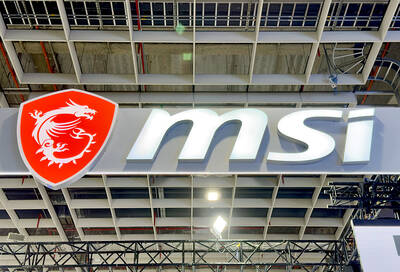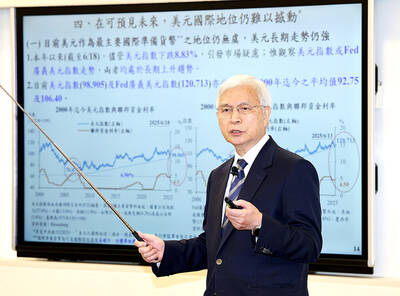Global shipment of LED lighting products are expected to jump 68 percent to 1.32 billion units next year as prices for mainstream 40-watt and 60-watt equivalent LED bulbs have fallen to the sweet spot of US$10 per unit in most parts of the world, local market researcher TrendForce Corp (集邦科技) said in a report.
As LED bulb prices have dropped to a comfortable level to replace traditional energy-saving lighting, most retailers, such as furniture maker IKEA, have distributed LED bulbs on the mass market, TrendForce said in a report on Monday.
Average selling price of mainstream 40-watt equivalent LED bulb dropped 2.3 percent to US$15.8 per unit in the global market last month on intensifying price competition, TrendForce said.
Meanwhile, the selling price of a 60-watt equivalent LED bulb rose 1.2 percent to US$21.6 last month as LED bulbmakers launched improved products, which carried a higher price tag, TrendForce said in the report.
“While the average selling prices of LED bulbs are falling steadily, the price span for different products remains wide, mainly because not every company is willing to sacrifice product quality for profits,” Roger Chu (儲余超), analyst at TrendForce’s LED market research division, said by telephone yesterday.
“Price remains the biggest
factor behind consumer purchasing behavior for LED products,” Chu said.
“With intensifying competition, LED suppliers hardly make decent profits, but they still need to roll out commercials to gain brand awareness and market share,” he added.
In Taiwan, because of the increased promotions offered by firms such as Everlight Electronics Co (億光電子) and Leotek Electronics Corp (光林電子), current market prices of 40-watt LED bulbs vary from about NT$100 to NT$300 as of last month, Chu said.
Meanwhile, prices of 60-watt LED bulbs ranged from NT$200 to NT$500 last month, he added.
“Taiwanese LED brands tend to adopt mass marketing strategies to increase consumer awareness, and that’s the reason why most firms can stay competitive, while facing price competition in the global market,” Chu said.
The 800-lumen 60-watt equivalent LED bulbs are popular because they provide a sufficient amount of brightness for household use, Chu said.
Lumen is a measure of the total amount of visible light emitted by the product.
However, because 60-watt equivalent LED bulbs are more expensive than 40-watt ones, consumers have been more willing to replace traditional incandescent bulbs with 40-watt LED bulbs, Chu added.

DIVIDED VIEWS: Although the Fed agreed on holding rates steady, some officials see no rate cuts for this year, while 10 policymakers foresee two or more cuts There are a lot of unknowns about the outlook for the economy and interest rates, but US Federal Reserve Chair Jerome Powell signaled at least one thing seems certain: Higher prices are coming. Fed policymakers voted unanimously to hold interest rates steady at a range of 4.25 percent to 4.50 percent for a fourth straight meeting on Wednesday, as they await clarity on whether tariffs would leave a one-time or more lasting mark on inflation. Powell said it is still unclear how much of the bill would fall on the shoulders of consumers, but he expects to learn more about tariffs

Meta Platforms Inc offered US$100 million bonuses to OpenAI employees in an unsuccessful bid to poach the ChatGPT maker’s talent and strengthen its own generative artificial intelligence (AI) teams, OpenAI CEO Sam Altman has said. Facebook’s parent company — a competitor of OpenAI — also offered “giant” annual salaries exceeding US$100 million to OpenAI staffers, Altman said in an interview on the Uncapped with Jack Altman podcast released on Tuesday. “It is crazy,” Sam Altman told his brother Jack in the interview. “I’m really happy that at least so far none of our best people have decided to take them

PLANS: MSI is also planning to upgrade its service center in the Netherlands Micro-Star International Co (MSI, 微星) yesterday said it plans to set up a server assembly line at its Poland service center this year at the earliest. The computer and peripherals manufacturer expects that the new server assembly line would shorten transportation times in shipments to European countries, a company spokesperson told the Taipei Times by telephone. MSI manufactures motherboards, graphics cards, notebook computers, servers, optical storage devices and communication devices. The company operates plants in Taiwan and China, and runs a global network of service centers. The company is also considering upgrading its service center in the Netherlands into a

NOT JUSTIFIED: The bank’s governor said there would only be a rate cut if inflation falls below 1.5% and economic conditions deteriorate, which have not been detected The central bank yesterday kept its key interest rates unchanged for a fifth consecutive quarter, aligning with market expectations, while slightly lowering its inflation outlook amid signs of cooling price pressures. The move came after the US Federal Reserve held rates steady overnight, despite pressure from US President Donald Trump to cut borrowing costs. Central bank board members unanimously voted to maintain the discount rate at 2 percent, the secured loan rate at 2.375 percent and the overnight lending rate at 4.25 percent. “We consider the policy decision appropriate, although it suggests tightening leaning after factoring in slackening inflation and stable GDP growth,”